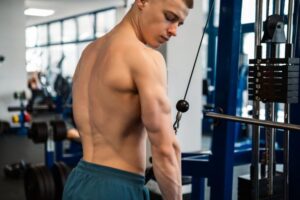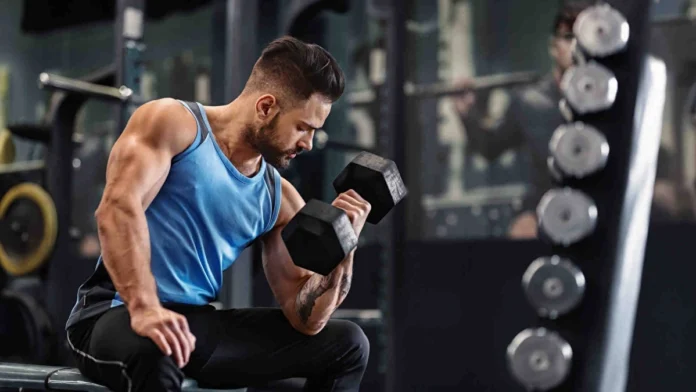Arm Muscles and Anatomy
The basis of an effective arm workout is to know the muscle groups you are working. Although the arm muscles have a complex structure, they can be examined in two main sections: the forearm and the back arm.
In the forearm area, there is a biceps muscle called the biceps brachii, which has a two-headed structure. The long head and short head of this muscle can be stimulated from different angles, and specific exercises are required for the development of each. The brachialis muscle, which accompanies the biceps, plays a strong supporting role in elbow bending movements, while the brachioradialis muscle, located in the forearm area, increases grip strength.

The triceps brachii muscle dominates the forearm. As its name suggests, this muscle has a three-headed structure: the long head, the medial head, and the lateral head. Interestingly, the triceps muscle is twice the size of the biceps in most people and makes up two-thirds of the total muscle mass in the upper arm. This anatomical fact shows how critical triceps training is to increasing arm size.
Understanding these muscle groups correctly is the foundation for creating an effective training program. Working each muscle group from different angles and movement patterns is essential for maximum development. In addition, since these muscles are constantly active in daily life, it is necessary to pay special attention to recovery processes when planning training.
The Right Program and Sufficient Training Volume
The most basic condition for strengthening weak arms is to apply scientifically proven training principles correctly. Training volume is the most critical determinant of muscle development and the most common mistake made in this regard is working with insufficient volume.
When calculating training volume, the most accepted method in recent years is to count “stimulus” reps. This approach emphasizes that reps that work the muscles to or near the point of exhaustion are what produce the actual muscle growth. For example, the last 5-6 reps in a set of 12 reps are effective for real muscle growth.
To give a practical example, if you do 3 exercises for biceps ( dumbbell curl , hammer curl, concentration curl) in your weekly arm workout and do 3 sets of each, you will reach a total volume of 105 reps. About 45 of these reps can be considered as “stimulus” reps. If progress is slow, you can increase your stimulating rep volume to 60 by increasing each exercise to 4 sets.
Since the arms are small muscle groups, they can be trained 2-3 times per week, but it’s ideal to stick to 3-4 exercises per session for a total of 12-16 sets. This approach ensures that the muscles receive adequate stimulation while also preventing you from overtraining.
To ensure your training program is sustainable and tailored to your personal goals, you can use the arm training programs in the MAC+ app. The app allows you to track your training volume and systematically monitor your progress.
Pay Attention to Exercise Forms
One of the most common problems with arm workouts is using the wrong exercise form. Especially those who are new to fitness use cheating repetitions in order to look impressive with heavy weights. This approach may provide short-term ego satisfaction, but it seriously hinders muscle development in the long term.
Creating momentum by swinging the body in a biceps curl, disrupting the position of the shoulder blades in a triceps pushdown, or moving the weight with momentum can dramatically reduce the overall load and tension experienced by the target muscles. For example, a 15kg biceps curl performed with correct form is much more effective than the same exercise performed with incorrect form in a 20kg lift.
The basic principles for proper form are: Controlling body position in a way that does not affect the mechanics of the exercise, maintaining full range of motion of the elbow joint, and applying a controlled tempo such as 2 seconds in the contraction phase and 3 seconds in the relaxation phase. Controlling the negative part of the movement (the lowering phase of the weight) in particular creates more micro-damage to the muscle fibers, supporting hypertrophy.

The position of the shoulder blades is critical in triceps exercises. Since the long head of the triceps connects to the shoulder blade, shoulder position directly affects the activation of this muscle. The long head is more active in shoulder flexion movements such as overhead triceps extensions, while the medial and lateral heads come to the fore in shoulder extension movements such as triceps kickbacks.
The most effective way to perfect exercise form is to complete motor learning by working with lighter weights at the beginning and gradually increasing the load. The quality of form should always come before the amount of weight.
Pay Attention to Your Nutrition Program
No matter how hard you train to develop lean arm muscles, if your eating habits are not correct, you will not be able to achieve the results you want. Building muscle is basically like building a building, and you need enough raw materials for this process.
Protein intake is the cornerstone of muscle growth. You need to consume 1.6-2.2 grams of protein for every kilogram of your body weight per day. For a 150-pound individual, this means about 112-154 grams of protein per day. Good sources of protein include eggs, chicken breast, lean red meat, fish, dairy products, and legumes.
Carbohydrates are critical to your workout performance. Consuming complex carbohydrates within 1-2 hours before your workout will replenish your muscle glycogen stores and provide the energy you need for intense arm workouts. Foods such as oats , whole grain bread, sweet potatoes and quinoa are ideal options.
Creating a calorie surplus is also necessary for muscle growth . Taking in more calories than you burn will help your body support anabolic (constructive) processes. However, this should not be too extreme; aiming for 200-500 calories above your daily calorie needs is sufficient.
Healthy fats should not be ignored. Omega-3 fatty acids reduce muscle inflammation and accelerate the recovery process. Sources such as walnuts, fish oil, avocado and olive oil are valuable in this regard.
Hydration is vital for muscle function. Drinking at least 2.5-3 liters of water a day ensures efficient muscle contractions and flushes toxins. This balance between nutrition and training is essential for the development of your arm muscles.

Give Due Importance to the Rest and Recovery Process
The real effect of training to strengthen weak arms comes not in the gym but during rest. Many people ignore this fact and focus on arm exercises every day, but this approach is one of the biggest mistakes that hinders development.
Muscle development is based on the principle that muscle fibers that have contracted during training are repaired and become stronger during the rest period. During this process, your body rebuilds damaged muscle fibers through anabolic hormones such as growth hormone and testosterone. However, this repair process cannot occur without adequate rest.
The optimal recovery time for arm muscles is between 48-72 hours. Therefore, training the same muscle group on consecutive days prevents the muscles from fully recovering and slows down development. Arm training 2-3 times a week is ideal for maintaining this balance.
Sleep quality is one of the most critical components of the process of strengthening weak arms. The growth hormone secreted between 22:00 and 02:00 at night is at the peak of muscle repair. 7-9 hours of quality sleep a day ensures the healthy functioning of this hormonal cycle.
Active rest is also important. Instead of remaining completely inactive, low-intensity activities such as light walking, yoga or stretching exercises increase blood circulation and speed muscle recovery.
Stress management is an often overlooked factor. Chronic stress disrupts the muscle-building process by causing excessive secretion of the hormone cortisol. Stress-reducing methods such as meditation, deep breathing exercises, or hobby activities support your goal of strengthening weak arms.
Focus on the Triceps Muscle
Many people who want to strengthen their weak arms make the big mistake of focusing solely on biceps training. However, the triceps muscle, which makes up two-thirds of the upper arm, is the main determining factor in increasing arm size. Ignoring this anatomical fact will limit the potential of your arms.
The triceps muscle has three different heads (long head, medial head, lateral head) which means it requires a variety of exercise angles and positions. The long head is more active in overhead movements because it runs across the shoulder joint. Exercises such as overhead triceps extensions or lying triceps extensions target this head effectively.
Since the lateral head and medial head are located in the area close to the elbow, they come to the fore in movements such as triceps pushdown or close grip bench press. The development of these muscle heads significantly increases the volume of the arm seen from the side profile.

A common mistake in triceps training is to limit range of motion by working with too heavy a weight. Since the triceps muscles experience maximum contraction in the fully extended position, it is critical that the arm is fully extended. Half reps prevent you from using the muscle’s potential.
Dips have a special place among effective triceps exercises. This movement, performed using body weight, works all heads of the triceps muscle simultaneously while also supporting functional strength development. This exercise, which can be done at home on the edge of a chair, is a practical option for strengthening weak arms.
Balancing triceps training with biceps training is critical for both aesthetic appearance and functional strength. The ideal ratio is to lighten the load on the triceps.
Diversify Your Training Program
One of the biggest obstacles in the process of strengthening weak arms is that the muscles get used to monotonous training routines and their development becomes stagnant. When your body is exposed to the same stimuli, it completes the adaptation process and looks for new challenges for more growth.
Exercise variety allows muscle fibers to be worked from different angles and lengths. For example, for the biceps, the difference between a standing barbell curl and an incline dumbbell curl is not just the equipment used. While the long head of the biceps is stretched more in the incline position, the classic standing curl targets the short head more effectively.
Grip variations are also important. A supinated grip, where the palms face up, engages the biceps brachii muscle more, a neutral grip (hammer curl) where the palms face each other engages the brachioradialis muscle more, and a pronated grip with the palms facing down engages the brachialis muscle more.
Tempo changes offer different types of stimulation to your muscles. Slowing down the eccentric phase (lowering the weight over 4-5 seconds) creates more microdamage to the muscle fibers, promoting hypertrophy. Speeding up the concentric phase encourages strength development.
Training methods should also be changed regularly. Techniques such as drop sets (gradually decreasing the weight), supersets (doing two exercises without a break) and pyramid sets (varying the number of repetitions by increasing or decreasing the weight) expose your muscles to non-habitual stimulation.
It’s also helpful to vary your workout frequency strategically. Working your arms twice a week some weeks, and three times a week some weeks, will keep your muscles in a constant state of adaptation. This variety will help maintain consistency in your goal of strengthening your weak arms.
Increase Your Grip Strength
An often overlooked but critical factor in strengthening weak arms is grip strength. If your forearm becomes exhausted, your workout will be over before your biceps and triceps muscles have reached their full potential. This prevents your target muscles from receiving adequate stimulation.
Grip strength affects stability throughout the upper body chain, not just the forearm muscles. A strong grip allows you to manipulate the weight with more control, while also strengthening the mind-muscle connection. This connection is essential for activating your target muscles more effectively.
The simplest way to develop grip strength is to hang from a pull-up bar. This static exercise works your forearm muscles isometrically while also providing support to your biceps and back muscles. In the beginning, hanging for 20-30 seconds is enough; over time, you can increase this time to 60-90 seconds.
Using a “fat grip” in dumbbell and barbell exercises is also an effective method. Grasping thicker diameter bars works your forearm muscles more, while also increasing your functional strength in daily life. If you don’t have a fat grip, you can create a similar effect by wrapping a towel around the bar.
Specific forearm exercises, such as wrist curls and reverse wrist curls, directly target your grip strength. These moves are ideal to do at the end of your arm workout, with light weights and high reps.
The farmers walk exercise is one of the most functional options for developing grip strength. Walking with heavy dumbbells at your sides strengthens both your forearm muscles and core stability.
Developing grip strength takes time, but this investment will give you a big advantage in your goal of strengthening weak arms. A strong grip allows you to work with heavier weights and accelerate your muscle growth.
How Does Excessive Arm Work Affect the Development of Lean Arms?
The relationship between hypertrophy and training volume follows an inverted U curve. This scientific fact shows that up to a certain point, increasing training volume promotes muscle growth, but once you exceed this optimum point, growth slows down or even stops. For small muscle groups, such as the biceps, this threshold is lower and the risk of overtraining is high. Training arms for more than 20 sets per week can be counterproductive for most people, exceeding the recovery capacity of the muscles and inhibiting growth.

What Training Variables Are Important for Developing Lean Arms?
Four basic training variables play a critical role in strengthening weak arms. Volume (total sets x reps), intensity (amount of weight used), frequency (number of times per week), and quality of technique are the most important of these variables. The ideal combination is: 2-3 times per week, 12-16 sets per session, 70-85% 1RM intensity, and excellent technique. Volume, intensity, or frequency should be gradually increased over time by applying the principle of progressive loading.
How Long Should It Take to Expect Results?
The first noticeable changes in the process of strengthening weak arms begin within 3-4 weeks. During this period, an increase in strength is observed first, followed by an improvement in muscle tone. Visually noticeable changes occur after 8-12 weeks of regular training. Significant muscle volume increases occur over a 4-6 month period. This timeline may vary depending on the person’s genetic makeup, training history, nutritional quality and resting habits. Patience and consistency are your most valuable investments in this process.
In summary;
Strengthening weak arms is a process that requires accurate information and a systematic approach. Understanding the anatomical structure of the arm muscles is the basis of an effective training program, while adequate training volume and correct exercise form are key factors in development. Prioritizing protein, maintaining a calorie surplus and hydration balance in your nutrition program directly affects your training results.
Effective rest and recovery processes should not be neglected as this is the main period when muscle development takes place. Focusing on the triceps muscle reveals the potential of this muscle group, which makes up two-thirds of the arm volume. While training variety prevents muscle adaptation, strong grip strength increases the effectiveness of all exercises.
Instead of overtraining, working at optimal volume, using training variables correctly, and creating realistic time expectations are essential for successful results. Systematic application of these seven basic suggestions is the most effective way to transform your weak arms into strong and aesthetic muscle groups. Muscle development is a marathon, and with patience, consistency, and the right methods, you can achieve your goals.



